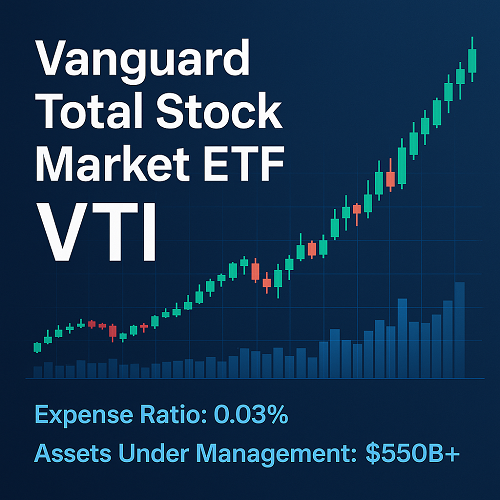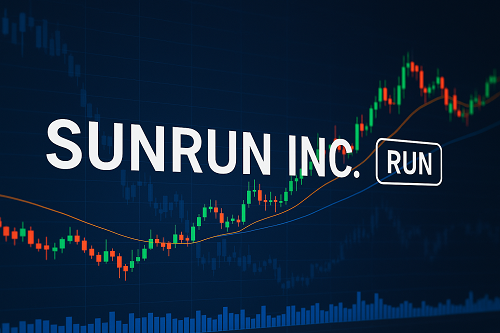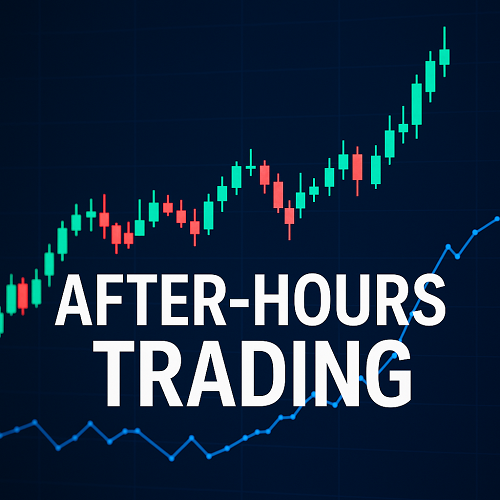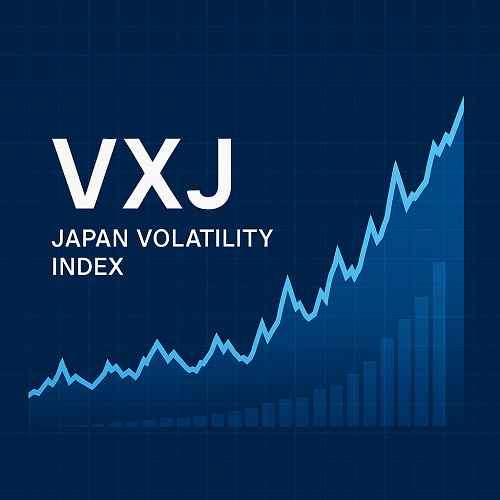The Vanguard Total Stock Market ETF (ticker: VTI) is a flagship U.S.-equity exchange-traded fund (ETF) issued by The Vanguard Group that provides nearly comprehensive exposure to the investable U.S. stock market. It covers large-cap, mid-cap, small-cap and micro-cap stocks—effectively allowing an investor to buy “the entire U.S. stock market” via one low-cost vehicle.
Key facts at a glance:
- Expense ratio: 0.03 % (ultra-low)
- Assets under management (AUM): ~$550 billion+ (and growing)
- Index tracked: the CRSP US Total Market Index, representing approximately the entire U.S. investable stock market.
- Holdings: Over 3,000 stocks across all market caps; top holdings include Apple, Microsoft, NVIDIA, Amazon, Meta.
- Fund structure: Passive index-fund/ETF, market-cap weighted, designed for broad diversification and cost efficiency. Trusted Tax Advisors
Because of its breadth, extremely low cost, and liquidity, many investors and advisors consider VTI to be a “core equity” building block in a long-term portfolio.
Why VTI matters: the case for broad U.S. equity exposure
1. Diversification across the U.S. market
Rather than selecting a handful of stocks or even just the large-cap segment (e.g., S&P 500), VTI spans large, mid, small, and micro-cap companies. That means you’re not just capturing the “big winners” but also smaller, emerging companies that may contribute to long-run growth.
2. Cost advantage
At 0.03% per year, VTI’s expense ratio is among the lowest in the industry. Cost matters in compounding returns over decades.
3. Simplicity and efficiency
A single ETF gives you access to thousands of U.S. stocks, which is extremely efficient. For many investors, owning VTI reduces the need to pick multiple individual stocks or attempt market timing. As one provider puts it:
“VTI = one ticker, thousands of companies, one super-simple way to own the U.S. market.”
4. Liquidity and tax-efficiency
Because VTI is widely traded and well-known, you benefit from good liquidity, tight bid-ask spreads, and tax-efficient structure typical of Vanguard ETFs.
Fund details & metrics
Here are some of the key quantitative metrics and fund details for VTI:
| Metric | Value / Details |
|---|---|
| Expense Ratio | 0.03% |
| AUM | ~$550 billion+ (various sources) |
| Number of Holdings | 3,500+ stocks (e.g., 3,531 in latest N-PORT) |
| Portfolio Turnover | Very low (2% in one source) |
| Dividend Yield | ~1.1%–1.2% (recent TTM) |
| Beta (vs U.S. market) | ~1.02 (meaning roughly market-level volatility) |
| Index Tracked | CRSP US Total Market Index |
| Inception Date | May 24, 2001 for VTI version |
Sector/Region Breakdown
- Region: ~99% U.S. stocks; very small international exposure.
- Sector: Technology is the largest (~33% in one source) followed by Financials (~13%), Consumer Cyclical (~10%), Communication Services (~9%), Healthcare (~9%).
Top Holdings (as of latest data)
Some of the largest positions include:
- Apple Inc. (~5.5-6.5%)
- Microsoft Corp. (~5.5-6.0%)
- NVIDIA Corp. (~5.5-6.2%)
- Amazon.com Inc. (~3.5%)
- Meta Platforms Inc. (~2.5%)
Because VTI is market-cap weighted, these mega-cap companies carry significant influence in the fund’s performance. As one article notes:
“The largest positions still carry the most weight … their influence on performance is strong.”
Performance – What has VTI delivered?
Performance is always backward-looking, but it gives a guide for what you might expect (with the understanding that past performance is not a guarantee of future results).
- According to one data source, the one-year total return (including dividends) for VTI was ~16.5%.
- Since inception (2001) the average annual return has been ~8.8% (per Investopedia) through ~2024.
- Because of its broad exposure, VTI’s returns tend to be very close to the U.S. market as represented by large-cap indices like the S&P 500; however small-cap exposure introduces some variation.
Historical Considerations
- When the U.S. market is in a strong bull-phase, VTI tends to do very well, riding the wave of broad economic growth and corporate earnings.
- Conversely, in periods of U.S. equity weakness, VTI will decline – because it is essentially the U.S. equity market.
- Because small- and micro-cap stocks are included, VTI may exhibit slightly higher volatility compared to an S&P 500-only product.
Strengths & Advantages
Here are the main advantages of owning VTI:
- Broad exposure – one fund gives you diversification across thousands of U.S. stocks rather than having to pick sectors or individual names.
- Low cost – the 0.03% expense ratio means fees drag on returns only minimally.
- Simplicity – easy to understand and implement; suitable for core long-term portfolio allocation.
- Tax efficiency – ETF structure, broad underlying portfolio, and low turnover help reduce unnecessary tax drag.
- Strong liquidity and scale – large assets and widespread recognition mean tight trading spreads and strong market presence.
- Alignment with passive investment philosophy – for those who believe in “owning the market” rather than trying to beat it, VTI fits well.
Risks & What to Watch
No investment is free of risk. Here are the key risk factors with VTI:
- Market risk – Because VTI essentially owns the U.S. stock market, a broad market downturn means your investment likely falls.
- Concentration in mega-caps – Even though VTI covers the full market, the weighting still means the biggest stocks dominate. That means large-cap risks (e.g., regulatory, valuation, sector rotation) are material. As one article said: “A handful of mega-cap stocks can dominate performance, creating potential concentration risk.”
- Small/micro-cap exposure – While this adds diversification, it also adds volatility. In downturns, smaller companies often suffer more.
- Valuation risk – Broad U.S. equities may be richly valued at times, which might dampen future returns. Some commentary has flagged this.
- Home-market bias – VTI is almost entirely U.S. stocks, so it lacks meaningful international diversification. Some investors may want to complement it with global exposure.
- Tracking error/benchmark differences – Though minor, even passive funds have small tracking differences versus the index they follow.
- Behavioral risk – Because the fund is so broad, investors might hold it through poor periods simply because of its simplicity; but long-term discipline is required.
How VTI fits into an investment portfolio
Using VTI as a “core” equity holding
Because VTI covers the entire U.S. market, many investors use it as the core of their equity allocation. Example portfolio allocation ideas:
- Baseline: 60 % equities / 40 % bonds → use VTI for the equity portion plus maybe some international equities.
- All-in U.S. equity: For investors comfortable being U.S.-centric, VTI may suffice for the equity slice.
- “Core + satellite”: Use VTI for broad exposure (core) and add smaller allocations to thematic or sector funds (satellites).
Complementary holdings
- International equities: Since VTI is U.S. only, consider something like VXUS (Vanguard Total International Stock ETF) for global diversification.
- Fixed income / bonds: To reduce overall portfolio volatility and add income.
- Alternative or factor funds: For example, to tilt growth, value, small-cap, or dividend strategies if desired.
- Dollar-cost averaging: Because VTI is for the long run, systematic investing (monthly or quarterly) can make sense.
Investor types who may prefer VTI
- Hands-off investors who want “set it and forget it” U.S. equity exposure.
- Long-term retirement investors (10-20+ years horizon).
- Cost-sensitive investors seeking maximum efficiency.
- Investors comfortable with U.S. market risk and willing to embrace market cycles.
Investor types who may want something else or supplement VTI
- Investors who want international equity exposure or emerging markets tilt.
- Those who believe in factor investing and want pure small-cap or value exposure (beyond what VTI provides).
- Short-term traders or those seeking tactical allocations (VTI is broad and passive).
- Investors who want higher income yield (VTI’s yield ~1.1% is modest).
VTI vs. Alternative ETFs
Here are some comparisons to help understand how VTI stacks against other options:
VTI vs. VOO (Vanguard S&P 500 ETF)
- VOO covers the ~500 largest U.S. companies (S&P 500).
- VTI covers the entire U.S. market including mid, small & micro caps.
- Cost is virtually the same (VOO also ~0.03%).
- Potential difference: VTI may perform slightly better over long periods due to additional small-cap exposure (but also may carry more volatility).
- If you believe the large-cap segment will dominate going forward, VOO might suffice; if you want full market breadth, choose VTI.
VTI vs. ITOT (iShares Core S&P Total U.S. Stock Market ETF)
- ITOT is similar in that it aims to replicate the entire U.S. market, so the difference is minor (fees, tracking, structure).
VTI vs. VT (Vanguard Total World Stock ETF)
- VT covers both U.S. and international stocks (~global equity).
- If you want global exposure in one fund, VT may be more suitable.
- If you prefer focusing on the U.S. first and layering international separately, VTI is excellent for the U.S. leg.
VTI vs. Small-cap or Value Funds
- Because VTI includes small and micro caps, part of your small-cap exposure is covered, but if you want a specific small-cap or value tilt you might use a dedicated fund.
- Some analysts argue that the small-cap/value premium may mean dedicated funds could outperform VTI in specific regimes—but that comes with higher risk.
Tax Considerations & Investor Practicalities
- The ETF shares of VTI are traded like stock, meaning intra-day buying and selling is possible (unlike some mutual funds which only trade end-of-day).
- Dividends are paid quarterly (in most recent data: ~$0.90 per share per quarter) with a yield around ~1.1–1.2%.
- The low turnover of the fund aids tax efficiency (fewer capital gains distributions).
- Holding in tax-advantaged accounts (e.g., IRAs, RRSPs for Canadians) helps especially for long-term investors; but using in taxable accounts is also reasonable given low turnover.
- Beware: U.S.-only exposure means you may miss currency/diversification benefits of international holdings.
How to Use VTI in 2025 & Beyond
Given current market conditions (as of October 2025), here are considerations for using VTI in your portfolio:
- Long-term outlook: If your horizon is 10+ years, owning broad U.S. equity through VTI makes sense as part of a diversified portfolio.
- Valuation watch: With many U.S. stocks trading at elevated valuations, you may want to temper expectations for future returns and ensure you have realistic plans for drawdowns.
- Diversification strategy: Even if you use VTI for U.S. equities, consider maintaining international, fixed income, and alternative allocations to smooth out risks.
- Cost-conscious investing: Because VTI is so cost-effective, it should form the foundation of any portfolio where cost control is important.
- Behavioral discipline: Broad market funds like VTI can still decline significantly in bad years. Set up your risk tolerance, allocation plan and stay consistent rather than trying to time markets.
- Rebalancing: Regularly rebalance to maintain your target asset allocation (for example, if VTI grows to 70 % of your portfolio but your target was 60 %, you might harvest some gains).
- Add via dollar-cost averaging: Since you already have so broad exposure, buying over time helps reduce timing risk.
Frequently Asked Questions (FAQ)
Q: Is VTI appropriate for a beginner investor?
Yes — because it is simple, diversified, and low-cost, VTI is often recommended as a core holding for beginner and experienced investors alike. Just ensure its asset-mix fits your risk tolerance.
Q: Should I hold VTI or a specialized ETF (like small-cap or sector-specific)?
It depends on your strategy. If you want broad market coverage and minimal decision complexity, VTI is ideal. If you believe you can pick or tilt certain segments (small-cap, value, growth, sectors) and accept the extra risk, then specialized funds might complement VTI.
Q: How does VTI perform compared to a pure large-cap index like the S&P 500?
Performance is often similar, because large-cap stocks dominate U.S. equity markets. However VTI includes mid- and small-cap stocks, which can enhance returns in certain periods but also add risk in downturns. Some data: VTI vs S&P-500 similar returns over long periods but small-cap component means slight differences.
Q: What are the downsides of VTI?
- You’re essentially “fully exposed” to U.S. equities — so if the U.S. economy or stock market suffers you will be impacted.
- Although diversified across caps, the weighting still leans heavily on mega-caps (which may be overvalued at times).
- International diversification is minimal — so you may miss non-U.S. opportunities or hedge against U.S.-specific risk.
- Dividend yield is modest (~1.1%) which may not satisfy income-oriented investors.
Q: How much should I allocate to VTI?
There’s no one-size-fits-all answer. It depends on your age, investment horizon, risk tolerance and broader asset mix. For many long-term investors, owning ~30–60% of portfolio in VTI could make sense (with the remainder in bonds, international equities, or alternative assets). Younger investors may allocate more to equities, older may allocate less.
Conclusion
The Vanguard Total Stock Market ETF (VTI) stands out as one of the most efficient, cost-effective, and broadly diversified ways to gain exposure to the U.S. stock market. Its ultra-low fees, comprehensive coverage, and simplicity make it an excellent candidate for a core equity holding, especially for long-term investors.
However, no fund is perfect. Because it is essentially “the U.S. equity market in a box,” it carries the full gamut of market risk — and lacks meaningful international diversification or specialized factor tilts. The key to success with VTI is alignment with your investment objectives, understanding its role in your broader portfolio, and maintaining a disciplined, long-term mindset.
For investors willing to commit over the long haul, maintain proper allocation, and resist emotional reactions to market swings, VTI offers a robust foundation. In many ways, owning VTI is less about trying to beat the market, and more about simply being the market — with all its ups and downs — in the most efficient way possible.





 XAUT-USD
XAUT-USD  AMD
AMD  MARA
MARA  SHOP
SHOP  BULL
BULL  CL=F
CL=F